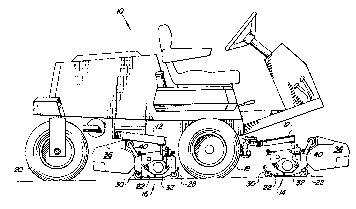Some of the information on this Web page has been provided by external sources. The Government of Canada is not responsible for the accuracy, reliability or currency of the information supplied by external sources. Users wishing to rely upon this information should consult directly with the source of the information. Content provided by external sources is not subject to official languages, privacy and accessibility requirements.
Any discrepancies in the text and image of the Claims and Abstract are due to differing posting times. Text of the Claims and Abstract are posted:
| (12) Patent: | (11) CA 2115865 |
|---|---|
| (54) English Title: | SLIDABLE GRASS CATCHER |
| (54) French Title: | ELEMENT COULISSANT POUR LA RECUPERATION DE L'HERBE |
| Status: | Expired and beyond the Period of Reversal |
| (51) International Patent Classification (IPC): |
|
|---|---|
| (72) Inventors : |
|
| (73) Owners : |
|
| (71) Applicants : |
|
| (74) Agent: | BORDEN LADNER GERVAIS LLP |
| (74) Associate agent: | |
| (45) Issued: | 1997-10-07 |
| (22) Filed Date: | 1994-02-17 |
| (41) Open to Public Inspection: | 1995-02-13 |
| Examination requested: | 1994-02-17 |
| Availability of licence: | N/A |
| Dedicated to the Public: | N/A |
| (25) Language of filing: | English |
| Patent Cooperation Treaty (PCT): | No |
|---|
| (30) Application Priority Data: | ||||||
|---|---|---|---|---|---|---|
|
A mechanism for collecting grass clippings cut by a
cutting unit, including a laterally extending member or rail
coupled with the cutting unit, a clippings container or basket
positioned for receiving clippings cut by the cutting unit,
first and second laterally spaced hook members operatively
coupled with the container for engaging the laterally
extending member to operatively couple the container with the
cutting unit, said mechanism allowing an operator standing at
one side of the vehicle to disengage the nearest hook member
from the rail to slide the container toward himself while the
other hook member slides along in engagement with the rail,
thereby facilitating removal.
Mécanisme pour recueillir le gazon coupé par une tondeuse, comprenant un élément ou un rail se déployant latéralement et couplé à la tondeuse, un contenant ou panier à gazon placé de façon à recevoir le gazon coupé par la tondeuse, un premier et un deuxième éléments à crochet espacés latéralement couplés en ordre de fonctionnement au contenant pour s'enclencher avec l'élément qui se déploye latéralement afin de coupler en ordre de fonctionnement le contenant à la tondeuse, ledit mécanisme permettant à un utilisateur se tenant sur un côté du véhicule de dégager l'élément à crochet le plus proche du rail pour faire glisser le contenant vers lui tandis que l'autre élément à crochet glisse de concert en s'engageant dans le rail, facilitant ainsi la dépose.
Note: Claims are shown in the official language in which they were submitted.
Note: Descriptions are shown in the official language in which they were submitted.

2024-08-01:As part of the Next Generation Patents (NGP) transition, the Canadian Patents Database (CPD) now contains a more detailed Event History, which replicates the Event Log of our new back-office solution.
Please note that "Inactive:" events refers to events no longer in use in our new back-office solution.
For a clearer understanding of the status of the application/patent presented on this page, the site Disclaimer , as well as the definitions for Patent , Event History , Maintenance Fee and Payment History should be consulted.
| Description | Date |
|---|---|
| Inactive: IPC deactivated | 2011-07-27 |
| Time Limit for Reversal Expired | 2007-02-19 |
| Inactive: First IPC derived | 2006-03-11 |
| Inactive: IPC from MCD | 2006-03-11 |
| Inactive: IPC from MCD | 2006-03-11 |
| Letter Sent | 2006-02-17 |
| Grant by Issuance | 1997-10-07 |
| Inactive: Application prosecuted on TS as of Log entry date | 1997-07-31 |
| Inactive: Status info is complete as of Log entry date | 1997-07-31 |
| Pre-grant | 1997-05-29 |
| Notice of Allowance is Issued | 1997-01-21 |
| Application Published (Open to Public Inspection) | 1995-02-13 |
| All Requirements for Examination Determined Compliant | 1994-02-17 |
| Request for Examination Requirements Determined Compliant | 1994-02-17 |
There is no abandonment history.
| Fee Type | Anniversary Year | Due Date | Paid Date |
|---|---|---|---|
| Final fee - standard | 1997-05-29 | ||
| MF (patent, 4th anniv.) - standard | 1998-02-17 | 1998-02-16 | |
| MF (patent, 5th anniv.) - standard | 1999-02-17 | 1999-02-16 | |
| MF (patent, 6th anniv.) - standard | 2000-02-17 | 2000-02-16 | |
| MF (patent, 7th anniv.) - standard | 2001-02-19 | 2001-02-16 | |
| MF (patent, 8th anniv.) - standard | 2002-02-18 | 2002-02-15 | |
| MF (patent, 9th anniv.) - standard | 2003-02-17 | 2003-02-14 | |
| MF (patent, 10th anniv.) - standard | 2004-02-17 | 2004-02-03 | |
| MF (patent, 11th anniv.) - standard | 2005-02-17 | 2005-02-02 |
Note: Records showing the ownership history in alphabetical order.
| Current Owners on Record |
|---|
| DEERE & COMPANY |
| Past Owners on Record |
|---|
| PHILLIP ORLAND SWENSON |
| RONALD LEE REICHEN |